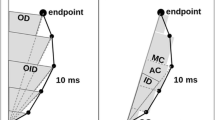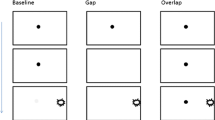Abstract
This study examined development of pro- and anti-saccadic eye movements in a cross-sequential research design. A hundred and seventeen subjects aged 6–18 years at initial testing were retested 18.9 ± 1.2 months later. Pro- and anti-saccades were elicited under the gap and overlap conditions. We found strong longitudinal developmental effects on all parameters analysed, in particular those derived from the anti-saccade task. These longitudinal changes structurally resembled the cross-sectional age effects observed for the same data. However, the principal component analyses of longitudinal “true” and raw difference scores revealed a stable three-factor solution that was robust to age effects and included (a) an express saccade factor, (b) a variability factor and (c) a factor consisting of direction errors with regular latencies and pro-saccadic RT. Cross-sectional factor analysis, by contrast, merged these two last-mentioned factors. We thus conclude that longitudinal data can provide unique information regarding individual differences in the patterns of developmental change.



Similar content being viewed by others
References
Armstrong IT, Munoz DP (2003) Inhibitory control of eye movements during oculomotor countermanding in adults with attention-deficit hyperactivity disorder. Exp Brain Res 152:444–452
Biscaldi M, Fischer B, Aiple F (1994) Saccadic eye movements of dyslexic and normal reading children. Perception 23(1):45–64
Biscaldi M, Fischer B, Stuhr V (1996) Human express-saccade makers are impaired at suppressing visually-evoked saccades. J Neurophys 76:199
Biscaldi M, Gezeck S, Stuhr V (1998) Poor saccadic control correlates with dyslexia. Neuropsychologia 36:1189–1202
Braun D, Weber H, Mergner T, Schulte-Monting J (1992) Saccadic reaction times in patients with frontal and parietal lesions. Brain 115(Pt5):1359–1386
Campbell DT, Stanley JC (1967) Experimental and quasi-experimental designs for research. Rand McNally & Co., Chicago
Cattell RB (1963) The structuring of change by P-technique and incremental R-technique. In: Harris CWE (ed) Problems measuring change. University of Wisconsin Press, Madison, pp 167–198
Cavegn D, Biscaldi M (1996) Fixation and saccade control in an express-saccade maker. Exp Brain Res 109:101–116
Cohen ME, Ross LE (1977) Saccadic latency in children and adults: effects of warning interval and target eccentricity. J Exp Child Psychol 23:539–549
Cohen ME, Ross LE (1978) Latency and accuracy characteristics of saccades and corrective saccades in children and adults. J Exp Child Psychol 26:517–527
Dorris MC, Pare M, Munoz DP (1997) Neuronal activity in monkey superior colliculus related to the initiation of saccadic eye movements. J Neurosci 17:8566–8579
Ettinger U, Piccioni M, Hall MH, Schulze K, Toulopoule T, Landau S et al (2006) Antisaccade performance in monozygotic twins discordant fpr Schizophrenia: the Maudsley twin study. Am J Psychiatry 163:543–545
Everling S, Fischer B (1998) The antisaccade: a review of basic research and clinical studies. Neuropsychologia 36:885–899
Fischer B, Weber H (1993) Express saccades and visual attention. Beh Brain Res 16:553–610
Fischer B, Weber H (1997) Effects of stimulus conditions on the performance of antisaccades in man. Exp Brain Res 116:191–200
Fischer B, Biscaldi M, Gezeck S (1997) On the development of voluntary and reflexive components in human saccade generation. Brain Res 754:285–297
Foerster F (1995) On the problems of initial-value-dependencies and measurement of change. J Psychophys 9:324–341
Foerster F (2003) The bio-signal analysis software BIO28. Ref Type: Unpublished Work
Fukushima J, Hatta T, Fukushima K (2000) Development of voluntary control of saccadic eye movements/i. age-related changes in normal children. Brain Dev 22:173–180
Hallett PE (1978) Primary and secondary saccades to goals defined by instructions. Vis Res 18:1279–1296
Heller KA, Kratzmeier H, Lengfelder A (1998) Standard progressive matrices/Matrizen-test-manual (Band 1). Beltz Test
Jensen AR (1992) The importance of intraindividual variation in reaction time. Person Individ Diff 13:869–881
Kingstone A, Klein RM (1993) Visual offsets facilitate saccadic latency: does predisengagement of visuospatial attention mediate this gap effect? J Exp Psychol (Hum Percept) 19:1251–1265
Klein C (2001) Developmental functions for parameters derived from pro- and anti-saccade tasks in 199 participants aged 6–28 years. Exp Brain Res 139:1–17
Klein C, Ettinger U (2008) A hundred years of eye movement research in psychiatry. Brain Cogn 68:215–218
Klein C, Fischer B (2005a) Developmental fractionation and differential discrimination of the anti-saccadic direction error. Exp Brain Res 165:132–138
Klein C, Fischer B (2005b) Instrumental and test-retest reliability of saccadic measures. Biol Psychol 68:201–213
Klein C, Foerster F (2001) Development of prosaccade and antisaccade task performance in participants aged 6 to 26 years. Psychophys 38:179–189
Klein C, Bruegner G, Foerster F, Mueller W, Schweickhardt A (2000a) Antisaccades and the saccadic gap effect in Schizotypal personality. Biol Psychol 55:25–39
Klein C, Heinks T, Andresen B, Berg P, Moritz S (2000b) Impaired modulation of the saccadic contingent negative variation preceding anti-saccades in Schizophrenia. Biol Psychiat 47:978–990
Klein C, Raschke A, Brandenbusch A (2003) Development of pro- and anti-saccades in children with attention-deficit hyperactivity disorder (ADHD) and healthy controls. Psychophys 40:17–28
Klein C, Foerster F, Hartnegg K, Fischer B (2005) Life-span development of pro- and anti-saccades: multiple regression models for point estimates. Developm Brain Res 160:113–123
Klein C, Wendling K, Huettner P, Ruder H, Peper M (2006) Intra-subject variability in attention-deficit hyperactivity disorder. Biol Psychiat 60:1088–1097
Klein C, Foerster F, Hartnegg K (2007) Regression-based developmental models exemplified for wisconsin card sorting test parameters: statistics and software for individual predictions. J Clin Expr Npsychol 29:25–35
Klein C, Rauh R, Biscaldi M (2010) Cognitive correlates of anti-saccade task performance. Exp Brain Res 203:759–764
Klein C, Arend I, Beauducel A, Shapiro KL (2011) Individuals differ in the attentional blink: mental speed and intra-subject variability matter. Intelligence 39:27–35
Kraemer HC, Yesavage JA, Taylor JL, Kupfer D (2000) How can we learn about developmental processes from cross-sectional studies, or can we? Am J Psychiatry 157:163–171
Kuntsi J, Oosterlaan J, Stevenson J (2001) Psychological mechanisms in hyperactivity: I. response inhibition deficit, working memory impairment, delay aversion, or something else? J Child Psychol Psychiat 42:199–210
Luciana M, Nelson CA (1998) The functional emergence of prefrontally-guided working memory systems in four- to eight-year-old children. Neuropsychologia 36(3):273–293
Luna B, Doll SK, Hegedus SJ, Minshew NJ, Sweeney JA (2006) Maturation of executive function in autism. Biol Psychiat 61:474–481
Luna B, Velanova K, Geier CF (2008) Development of eye movement control. Brain Cogn 68:293–308
Massen C (2004) Parallel programming of exegenous and endogenous components in the antisaccade task. Quart J Exp Psychol 57:475–498
McDowell JE, Dyckman KA, Austin BP, Clementz BA (2008) Neurophysiology and neuroanatomy of reflexive and volitional saccades: evidence from studies of humans. Brain Cogn 68:255–270
Munoz DP, Broughton JR, Goldring JE, Armstrong IT (1998) Age-related performance of human subjects on saccadic eye movement tasks. Exp Brain Res 121:391–400
Munoz DP, Armstrong IT, Hampton KA, Moore KD (2003) Altered control of visual fixation and saccadic eye movements in attention-deficit hyperactivity disorder. J Neurophys 90:503–514
Müri RM, Nyffeler T (2008) Neurophysiology and neuroanatomy of reflexive and volitional saccades as revealed by lesion studies with neurological patients and transcranial magnetic stimulation (TMS). Brain Cogn 68:284–292
Reuter-Lorenz PA, Oonk HM, Barnes L, Hughes HC (1995) Effects of warning signals and fixation point offsets on the latencies of pro- versus antisaccades: implications for an interpretation of the gap effect. Exp Brain Res 103:287–293
Saslow MG (1967) Effects of components of displacement step stimuli upon latency for saccadic eye movements. J Opt Soc Am 57:1024–1029
Schaie KWE (2005) What can we learn from longitudinal studies of adult development? Res Human Dev 2:133–158
Smyrnis N, Karantinos T, Malogiannis I, Theleritis C, Mantas A, Stefanis NC, Hatzimanolis J, Evdokimidis I (2008) Larger variability of saccadic reaction times in Schizophrenia patients. Psychiatry Res 168:129–136
Author information
Authors and Affiliations
Corresponding author
Additional information
This research was supported by the Deutsche Forschungsgemeinschaft (Kl 985/6-1).
Rights and permissions
About this article
Cite this article
Klein, C., Rauh, R. & Biscaldi, M. Patterns of change in ocular motor development. Exp Brain Res 210, 33–44 (2011). https://doi.org/10.1007/s00221-011-2601-7
Received:
Accepted:
Published:
Issue Date:
DOI: https://doi.org/10.1007/s00221-011-2601-7




